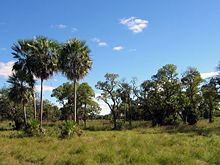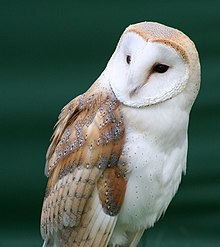Pseudoryzomys
| Pseudoryzomys simplex | |
|---|---|

| |
Lectotype skull as illustrated by Winge in 1888
| |
| Scientific classification | |
| Domain: | Eukaryota |
| Kingdom: | Animalia |
| Phylum: | Chordata |
| Class: | Mammalia |
| Order: | Rodentia |
| Family: | Cricetidae |
| Subfamily: | Sigmodontinae |
| Genus: | Pseudoryzomys Hershkovitz, 1962[fn 1] |
| Species: | P. simplex
|
| Binomial name | |
| Pseudoryzomys simplex (Winge, 1888)
| |

| |
| Distribution of Pseudoryzomys in South America (in red); fossil record from Cueva Tixi, eastern Argentina, in blue | |
| Synonyms | |
| |
Pseudoryzomys simplex, also known as the Brazilian false rice rat
The
Taxonomy
Discovery and recognition
Pseudoryzomys simplex has had a complex
In 1921, renowned British mammalogist Oldfield Thomas described Oryzomys wavrini as a new species of Oryzomys from Paraguay. In the next decades, it was viewed as an aberrant species of Oryzomys (then used in a much broader sense than now),[7] but it was moved to a separate genus, named Pseudoryzomys, by Hershkovitz in 1959, who noted that although it is similar to Oryzomys palustris in appearance, other features suggest it is more closely related to Phyllotis.[8] Thus, he viewed the animal as a member of the phyllotine group of rodents, which includes Calomys and Phyllotis, not of the oryzomyine group, which includes Oryzomys,[9] and his opinion was mostly accepted in the next few decades. Scientific knowledge of the rare Pseudoryzomys wavrini—only three specimens were known when Hershkovitz described the genus Pseudoryzomys in 1959[10]—increased in the following years, and in 1975 the Bolivian population was named as a separate subspecies, Pseudoryzomys wavrini reigi, because Bolivian animals are slightly larger and darker than those from Paraguay.[7]
In 1980, Argentinean zoologist Elio Massoia suggested that Winge's Hesperomys simplex and the living Pseudoryzomys wavrini are in fact the same species. In a 1991 study, American zoologists Voss and Myers confirmed this suggestion after re-examining Winge's material, finding no appreciable differences among specimens of H. simplex and P. wavrini. Since then, the species has been known as Pseudoryzomys simplex (Winge, 1888), because simplex is the oldest specific name for the animal; Oryzomys wavrini Thomas, 1921, and Pseudoryzomys wavrini reigi Pine and Wetzel, 1975, are junior synonyms. Voss and Myers also re-evaluated the relationships of Pseudoryzomys; they considered it closer to oryzomyines than to phyllotines, but declined to formally place it in Oryzomyini in the absence of explicit phylogenetic justification for such a placement.[11]
Oryzomyine relationships
| ||||||||||||||||||||||||||||||||||||||||||
| Relationships of Pseudoryzomys based on morphology (top) and IRBP (bottom).[12] |
When Voss and Carleton formally characterized Oryzomyini two years later, they did place Pseudoryzomys in the group, even though it lacks complete
Several phylogenetic studies published during the 1990s and 2000s supported a close relationship between Pseudoryzomys and two other oryzomyines with reduced or absent mesoloph(id)s, Lundomys and Holochilus. The extinct genera Noronhomys and Carletonomys, described in 1999 and 2008 respectively, were also recognized as members of the group.[15] In 2006, a broad morphological and molecular phylogenetic study of Oryzomyini provided further support for the relationship between Holochilus, Lundomys, and Pseudoryzomys. Within this group, morphological data supported a closer relationship between Holochilus and Lundomys to the exclusion of Pseudoryzomys, but DNA sequence data favored a clustering between Holochilus and Pseudoryzomys to the exclusion of Lundomys; among all oryzomyines, this was the only case where relationships which received strong support from morphological and DNA sequence data conflicted.[16] Together, the three genera form part of a large group of oryzomyines ("clade D"), which contains tens of other species. Several of those display some adaptations to life in the water, being partially aquatic, as do Pseudoryzomys and its relatives. Morphological data indicate that the genus Oryzomys is the closest relative of the group that includes Pseudoryzomys, but DNA sequence data from the nuclear IRBP gene did not support this relationship; convergent adaptations towards a semiaquatic lifestyle may explain the morphological support for a relation between Oryzomys and the other three genera.[17]
Description
Pseudoryzomys simplex is a nondescript, medium-sized rat with long, soft fur. The upperparts are gray–brown and the underparts are

The female has four pairs of
Skull
The skull, which is short at the front, shows some typical oryzomyine characters. The
The
The
The mandible (lower jaw) is short and deep.[23] The mental foramen, an opening at the front of the mandible, just before the first molar, opens to the side.[33] The capsular process of the lower incisor, a raising of the mandibular bone at the back end of the incisor, is well developed. The two masseteric ridges, to which some of the chewing muscles are attached, are entirely separate, joining only at their front edges, which are located below the first molar.[34]
Molars

As in all oryzomyines except Holochilus and its close relatives, the molars are
As in all oryzomyines, the upper molars all have one root on the inner (lingual) side and two on the outer (labial) side; in addition, the first upper molar in Pseudoryzomys and some other species has another labial root. The first lower molar has large roots at the front and back of the tooth and two smaller ones in between, at the labial and lingual side. The second and third lowers molars have two roots at the front, one labial and one lingual, and another at the back.[23]
Postcranial skeleton
Pseudoryzomys has 19 or 20
Karyotype
The
Distribution, ecology, and variation

Pseudoryzomys simplex is known from northeastern Argentina, probably south to about 30°S,[44] northward through western Paraguay to eastern Bolivia and from there eastward through Brazil in the states of Mato Grosso, Goiás, Tocantins, Minas Gerais, São Paulo, Bahia, and far in the northeast, Alagoas and Pernambuco.[45] Paraguayan animals are somewhat smaller than those from Bolivia and Brazil and those from Bolivia have darker fur than Paraguayan specimens, but these differences are not considered significant enough to recognize subspecies. Certain bats show a similar pattern of variation: they are smaller and paler in the Chaco region, which includes much of Paraguay.[7] Two specimens from Paraguay, collected 600 kilometres (400 mi) apart, differed by 1.4% in the sequence of the cytochrome b gene,[46] but nothing is known about genetic variation in other parts of the range. The species has long been rare in collections; in 1991, Voss and Myers could use less than 50 specimens for their study of the species, including Lund's fragmentary material from Lagoa Santa.[47]
A fragmentary lower jaw of "Pseudoryzomys aff. P. simplex" (i.e., an unnamed species close to Pseudoryzomys simplex) is known from a cave deposit in Cueva Tixi, Buenos Aires Province, Argentina, outside the current distribution of the species. It is dated from the first millennium CE. The jaw's morphology agrees with that of P. simplex, but the toothrow is relatively long (5.78 mm; 4.61 to 5.60 mm in three specimens of P. simplex) and the first molar is relatively narrow (1.28 mm; 1.30 to 1.40 mm in five P. simplex).[48]
P. simplex inhabits open, usually humid tropical and subtropical lowlands.[49] In Argentina, it is mainly a species of the eastern Chaco[50] and in Brazil it is found in the Cerrado and Caatinga.[51] Most specimens for which habitat data are known were caught on the ground in humid grassland, some in seasonally flooded areas;[52] an Argentinean specimen was captured in dense swamp vegetation.[50] It is terrestrial and semiaquatic, living on the ground but also spending time in the water.[53]
Nothing is known about behavior or diet. P. simplex has frequently been found in pellets of the barn owl (Tyto alba)[44] and also in those of the great horned owl (Bubo virginianus).[54] It is a preferred prey of the maned wolf (Chrysocyon brachyurus).[55]
Conservation status
The species is not known to be threatened and its conservation status is classified as
Footnotes
- ^ Hershkovitz introduced the genus name Pseudoryzomys in a 1959 article, but failed to make the name available under the International Code of Zoological Nomenclature, because he did not explicitly name the diagnostic characteristics of the genus. In his 1962 monograph on phyllotine rodents, Hershkovitz properly identified diagnostic characters, making the name formally available for the first time. Accordingly, the correct year of publication for Pseudoryzomys is 1962, not 1959.[2]
References
- ^ a b c Percequillo et al., 2016
- ^ Voss and Myers, 1991, p. 418
- ^ Musser and Carleton, 2005, p. 1164
- ^ Winge, 1888
- ^ Voss and Carleton, 1993, p. 31
- ^ Hershkovitz, 1960, pp. 519–520
- ^ a b c Voss and Myers, 1991, p. 424
- ^ a b Hershkovitz, 1959, pp. 8–9
- ^ Hershkovitz, 1962, p. 208
- ^ Hershkovitz, 1959, p. 9
- ^ a b c Voss and Myers, 1991, p. 423
- ^ Weksler, 2006, figs. 34–36
- ^ Voss and Carleton, 1993, p. 31–32
- ^ Musser and Carleton, 2005, table 1
- ^ Pardiñas, 2008, p. 1275
- ^ Weksler, 2006, p. 72
- ^ Weksler, 2006, p. 131
- ^ Voss and Myers, 1991, p. 420
- ^ Weksler, 2006, pp. 23–25
- ^ Voss and Myers, 1991, tables 1, 2; Bonvicino et al., 2008, p. 54
- ^ Weksler, 2006, pp. 17, 19, 58–59
- ^ Weksler, 2006, pp. 55–56
- ^ a b c d e Voss and Myers, 1991, p. 422
- ^ Weksler, 2006, pp. 27–28, table 5
- ^ Weksler, 2006, pp. 28–30, table 5
- ^ Weksler, 2006, p. 31
- ^ Voss and Myers, 1991, p. 422; Weksler, 2006, p. 31
- ^ Weksler, 2006, p. 32, table 5
- ^ Weksler, 2006, pp. 31–32
- ^ Weksler, 2006, pp. 35–36, 131
- ^ Weksler, 2006, p. 35
- ^ Weksler, 2006, p. 36
- ^ a b Weksler, 2006, p. 41
- ^ Weksler, 2006, p. 42
- ^ Voss and Myers, 1991, p. 416
- ^ Weksler, 2006, pp. 43–44; Pardiñas, 2008, table 2
- ^ a b Weksler, 2006, p. 52
- ^ Weksler, 2006, p. 131; Carleton and Olson, 1999, pp. 49–50
- ^ a b Weksler, 2006, p. 53
- ^ Weksler, 2006, p. 55
- ^ Voss and Myers, 1991, p. 423; Bonvicino et al., 2005, p. 399; Moreira et al., 2013, p. 202
- ^ a b Moreira et al., 2013, p. 202
- ^ a b Moreira et al., 2013, p. 204
- ^ a b c Pardiñas et al., 2004, p. 105
- ^ Musser and Carleton, 2005, p. 1164; Bonvicino et al., 2008, p. 54
- ^ D'Elia et al., 2008, p. 49
- ^ Voss and Myers, 1991, pp. 426–427
- ^ Pardiñas, 1995, pp. 199–201
- ^ Voss and Myers, 1991, p. 425
- ^ a b Pardiñas et al., 2004, p. 108
- ^ Bonvicino et al., 2008, p. 54
- ^ Voss and Myers, 1991, p. 426; Bonvicino et al., 2005, p. 399; D'Elia et al., 2008, p. 49
- ^ Hershkovitz, 1962, p. 213; Bonvicino et al., 2008, p. 54; Wetzel and Lovett, 1974, p. 211
- ^ Chebez et al., 2005, p. 484
- ^ Belentani et al., 2005, p. 96
- ^ Díaz and Ojeda, 2000
Literature cited
- Belentani, S.C. da S., Motta-Junior, J.C. and Talamoni, S.A. 2005. Notes on the food habits and prey selection of the maned wolf (Chrysocyon brachyurus) (Mammalia, Canidae) in southeastern Brazil. Biocièncias 13(1):95–98.
- Bonvicino, C.R., Lemos, B. and Weksler, M. 2005. Small mammals of Chapada dos Veadeiros National Park (Cerrado of Central Brazil): Ecologic, karyologic, and taxonomic considerations. Brazilian Journal of Biology 65(3):395–406.
- Bonvicino, C.R., Oliveira, J.A. and D'Andrea, P.S. 2008. Guia dos Roedores do Brasil, com chaves para gêneros baseadas em caracteres externos. Rio de Janeiro: Centro Pan-Americano de Febre Aftosa – OPAS/OMS, 120 pp. (in Portuguese). ISSN 0101-6970
- Carleton, M.D. and Olson, S.L. 1999. Amerigo Vespucci and the rat of Fernando de Noronha: a new genus and species of Rodentia (Muridae, Sigmodontinae) from a volcanic island off Brazil's continental shelf. American Museum Novitates 3256:1–59.
- Chebez, J.C., Pereira, J., Massoia, E., Di Giacomo, A.G. and Fortabat, S.H. 2005. Mamíferos de la Reserva El Bagual. Temas de Naturaleza y Conservación 4:467–499 (in Spanish).
- D'Elia, G., Mora, I., Myers, P. and Owen, R.D. 2008. New and noteworthy records of Rodentia (Erethizontidae, Sciuridae, and Cricetidae) from Paraguay (subscription required for full paper). Zootaxa 1784:39–57.
- Díaz, G. and Ojeda, R. 2000. Libro Rojo de los mamíferos amenazados de la Argentina. Mendoza: Sociedad Argentina para el Estudio de los Mamíferos, 106 pp. (in Spanish). ISBN 978-987-98497-0-5
- Hershkovitz, P.M. 1959. Two new genera of South American rodents (Cricetinae). Proceedings of the Biological Society of Washington 72:5–10.
- Hershkovitz, P.M. 1960. Mammals of northern Colombia, preliminary report no. 8: Arboreal rice rats, a systematic revision of the subgenus Oecomys, genus Oryzomys. Proceedings of the United States National Museum 110:513–568.
- Hershkovitz, P. 1962. Evolution of Neotropical cricetine rodents (Muridae) with special reference to the phyllotine group. Fieldiana Zoology 46:1–524.
- Moreira, C.N., Di-Nizo, C.B., Silva, M.J.d.J., Yonenaga-Yassuda, Y. and Ventura, K. 2013. A remarkable autosomal heteromorphism in Pseudoryzomys simplex 2n = 56; FN = 54-55 (Rodentia, Sigmodontinae) (subscription required). Genetics and Molecular Biology 36(2):201–206.
- OCLC 62265494.
- Pardiñas, U.F.J. 1995. Novedosos cricetidos (Mammalia, Rodentia) en el Holoceno de la Región Pampeana, Argentina. Ameghiniana 32(2):197–203 (in Spanish).
- Pardiñas, U.F.J. 2008. A new genus of oryzomyine rodent (Cricetidae: Sigmodontinae) from the Pleistocene of Argentina (subscription required). Journal of Mammalogy 89(5):1270–1278.
- Pardiñas, U.F.J., Cirignoli, S. and Galliari, C.A. 2004. Distribution of Pseudoryzomys simplex (Rodentia: Cricetidae) in Argentina. Mastozoología Neotropical 11(1):105–108.
- Percequillo, A.; Weksler, M.; Pardinas, U.; D'Elia, G. (2017) [errata version of 2016 assessment]. "Pseudoryzomys simplex". .
- Voss, R.S. and Carleton, M.D. 1993. A new genus for Hesperomys molitor Winge and Holochilus magnus Hershkovitz (Mammalia, Muridae) with an analysis of its phylogenetic relationships. American Museum Novitates 3085:1–39.
- Voss, R.S. and Myers, P. 1991. Pseudoryzomys simplex (Rodentia: Muridae) and the significance of Lund's collections from the caves of Lagoa Santa, Brazil. Bulletin of the American Museum of Natural History 206:414–432.
- Weksler, M. 2006. Phylogenetic relationships of oryzomyine rodents (Muroidea: Sigmodontinae): separate and combined analyses of morphological and molecular data. Bulletin of the American Museum of Natural History 296:1–149.
- Wetzel, R.M. and Lovett, J.W. 1974. A collection of animals from the Chaco of Paraguay. University of Connecticut Occasional Papers 2(13):203–216.
- Winge, H. 1888. Jordfundne og nulevende Gnavere (Rodentia) fra Lagoa Santa, Minas Geraes, Brasilien. E Museo Lundii 1(3):1–200.

